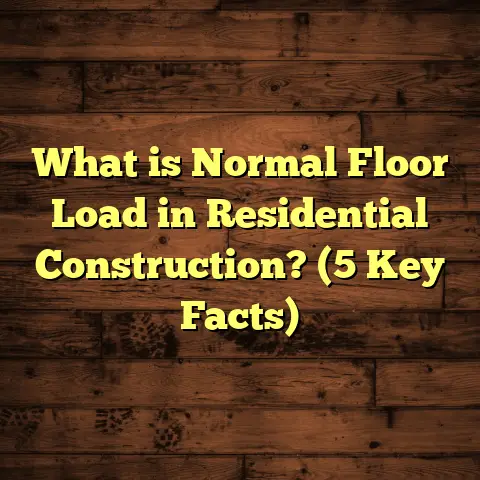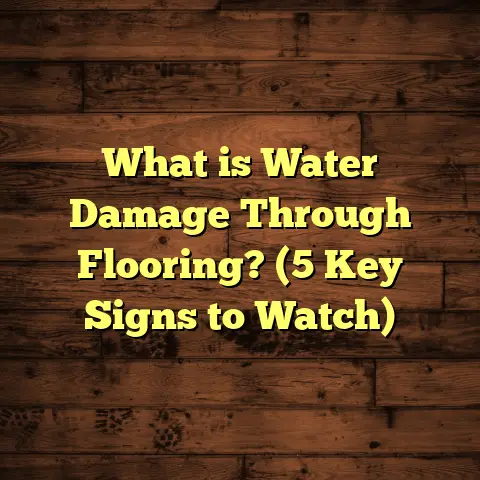What is Dry Back Vinyl Flooring? (5 Benefits for Your Home)
I’ve always been fascinated by the floors we walk on every day. They hold stories, memories, and a lot of wear and tear. One type of flooring that has caught my attention repeatedly over the years is dry back vinyl flooring. When I first encountered it on a project, I wasn’t entirely sure what to expect. But after installing it in dozens of homes and commercial spaces, I’ve come to appreciate its unique qualities. If you’re curious about what dry back vinyl flooring is and why it might be a great fit for your home, stick with me. I’m going to share everything I know, including some personal experiences, detailed data, and practical advice.
What is Dry Back Vinyl Flooring?
Let’s start with the basics. Dry back vinyl flooring refers to vinyl sheets or tiles that are glued permanently onto a substrate using an adhesive. Unlike peel-and-stick or click-lock vinyl options, dry back vinyl requires a professional installation method where the adhesive bonds the material firmly to the floor underneath.
Technical Explanation
Vinyl flooring itself is made primarily from polyvinyl chloride (PVC) combined with plasticizers to give it flexibility. Dry back vinyl comes in sheets typically 6 to 12 feet wide, which installers cut to size on-site. Thickness can vary, but most residential-grade sheets range from 1.5 mm to 3 mm.
The adhesive is usually a pressure-sensitive or wet-set glue applied evenly to the subfloor before laying down the vinyl. This process ensures a tight bond with minimal air pockets or bubbles.
Why “Dry Back”?
The term “dry back” distinguishes this glue-down method from other vinyl installation types where the backing might be loose-laid or attached differently. Dry back vinyl offers a smooth, flat surface and is less prone to shifting or curling.
Suitable Subfloors
Dry back vinyl can be installed over concrete, wood, or existing resilient floors provided the surface is clean, smooth, and level within 3/16 inch over 10 feet. Uneven surfaces require leveling compounds before installation.
Installation Timeframe
For a typical residential kitchen or bathroom (about 150-200 square feet), installation takes roughly 1 to 2 days:
- Day 1: Subfloor inspection and preparation (cleaning, leveling).
- Day 2: Adhesive application and vinyl laying.
- Additional curing time for adhesive ranges from 12 to 24 hours.
For larger areas or commercial projects over 1,000 square feet, installation can stretch up to a week depending on complexity.
Cost Breakdown
Based on my work across several states including Texas, Florida, and California, here’s a rough cost outline per square foot:
| Item | Cost Range |
|---|---|
| Vinyl material | $2.00 – $5.00 |
| Adhesive | $0.50 – $1.00 |
| Labor (installation) | $1.50 – $3.00 |
| Subfloor prep | $0 – $2.00 |
| Total per sq ft | $4.00 – $11.00 |
For example, installing dry back vinyl in a 300-square-foot living room could cost between $1,200 and $3,300 depending on material quality and labor rates.
My Journey with Dry Back Vinyl Flooring: Real-Life Stories
One of the most memorable projects I worked on was in Denver. The client wanted something durable for their entryway and kitchen because their dog frequently tracked in mud and water. We chose a dry back vinyl sheet with a stone-look pattern that had a 12 mil wear layer for extra protection.
The subfloor was concrete that needed leveling due to uneven spots — about 1/4 inch difference across the room. After applying a self-leveling compound and letting it cure for 48 hours, I spread the adhesive carefully using a notched trowel to ensure even coverage.
Laying the vinyl was surprisingly quick once prep was done — the sheet measured 9 feet wide and covered both rooms seamlessly without visible seams except where cuts fit around cabinets.
Six months later when I visited for a follow-up consultation, the client showed me how easy cleanup was after muddy paws had passed through daily. The floor looked brand new — no scratches or discoloration.
Benefits of Dry Back Vinyl Flooring for Your Home
You might wonder what makes dry back vinyl a great choice compared to other options like laminate or hardwood? Here are five key benefits I’ve noticed time and again.
1. Durability That Keeps Up With Life
This flooring type holds up well under heavy foot traffic and common household accidents like dropped objects or spilled liquids.
Vinyl’s wear layer is essential here — it’s a transparent top coat protecting printed designs underneath. In residential settings, I recommend at least 12 mil thickness for high-use rooms like kitchens and hallways.
According to data from the Resilient Floor Covering Institute (RFCI), high-quality dry back vinyl can last 15-20 years when installed correctly.
2. Water Resistance Means Worry-Free Cleaning
Unlike hardwood or laminate floors that swell or warp when exposed to moisture, dry back vinyl is inherently waterproof.
This makes it an excellent choice for kitchens, bathrooms, basements, or laundry rooms where spills are frequent.
In my experience installing floors in humid climates like Florida and coastal California, this feature is invaluable.
3. Design Options That Fit Any Taste
If you want floors that look like real wood planks, natural stone slabs, or even tile patterns without the cost and maintenance headaches — dry back vinyl delivers.
Manufacturers use advanced digital printing technology to create high-resolution images embedded into the vinyl surface.
For example, I recently installed a luxury vinyl sheet mimicking Italian marble in a client’s bathroom in New York City that stunned guests at their housewarming party.
4. Comfort You Can Feel
Walking barefoot on hard tile can be tough after standing for hours cooking or entertaining.
Dry back vinyl provides a softer underfoot feel because of its flexible composition and slight cushioning effect compared to rigid materials.
Clients often report less foot fatigue after switching from tile or concrete floors to vinyl.
5. Budget-Friendly Without Sacrificing Style
Cost efficiency is one reason many homeowners select dry back vinyl flooring.
You get the look of expensive hardwood or stone at a fraction of the price — plus lower installation costs due to faster installation times compared to tile or wood sanding/finishing.
How I Use FloorTally for Cost Estimating
Budgeting flooring projects can be tricky if you don’t have accurate local pricing data or waste factors handy.
That’s where FloorTally comes in handy for me. It allows me to enter room dimensions, choose materials based on quality and thickness preferences, and set waste percentages (usually 5-10%) for cuts and mistakes.
FloorTally also pulls in current local labor rates for installers which vary widely by region — for instance:
- Houston: $1.80 per sq ft labor
- Chicago: $2.50 per sq ft labor
- Los Angeles: $3.00 per sq ft labor
By generating detailed estimates upfront, I avoid unpleasant surprises later on and help clients plan their budgets confidently.
Installation Process: What Happens Step-by-Step?
If you haven’t seen dry back vinyl being installed before, here’s what typically happens:
Step 1: Subfloor Preparation
This is critical because any bumps or debris can cause bubbles under the vinyl later on.
I inspect for cracks, holes, or unevenness greater than 3/16 inch over 10 feet.
Then I clean thoroughly using vacuum and mop — any dust left behind affects adhesive bonding badly.
If needed, I apply a self-leveling compound which usually takes between 12-48 hours to cure depending on product specs.
Step 2: Measuring and Cutting
Once the subfloor is ready, I measure each room carefully accounting for door trims, cabinets, or other obstacles.
Vinyl sheets are cut slightly larger than needed so adjustments can be made onsite for perfect fit.
Step 3: Applying Adhesive
Using a notched trowel designed for glue-down vinyl installation ensures an even adhesive layer that avoids lumps or thin spots that cause problems later.
Pressure-sensitive adhesives allow some repositioning during installation; wet-set adhesives require quicker placement but provide very strong bonds once cured.
Step 4: Laying Vinyl Sheets
Starting from one end of the room, I carefully lay down each sheet making sure edges align perfectly with walls or trims.
I use a roller tool repeatedly across the floor surface applying pressure that eliminates trapped air pockets ensuring full contact with adhesive underneath.
Seams between sheets are sealed with special seam adhesive or tape to prevent moisture intrusion or lifting over time.
Step 5: Clean-Up and Curing
After laying all sheets and sealing seams if necessary, I clean excess adhesive immediately using manufacturer-approved solutions.
The floor then needs to cure undisturbed for at least 12 hours (sometimes longer depending on adhesive type) before furniture can be moved back in.
Comparing Dry Back Vinyl Flooring with Other Flooring Types
If you’re still unsure whether dry back vinyl is right for your space, comparing it with other popular flooring options might help:
| Feature | Dry Back Vinyl | Hardwood | Laminate | Tile |
|---|---|---|---|---|
| Installation Time | 1-3 days | Several days – weeks | 1-3 days | Several days – weeks |
| Cost per sq ft | $4-$11 | $8-$15+ | $3-$7 | $5-$15 |
| Water Resistance | High | Low | Moderate | High |
| Durability | High | High (with care) | Moderate | Very High |
| Comfort | Medium | High | Medium | Low |
| Maintenance | Low | Moderate | Low | Moderate |
| Appearance Options | Very Flexible | Natural beauty | Wood look only | Stone/tile variety |
Common Challenges and How I Handle Them
Like any flooring type, dry back vinyl has challenges:
- Subfloor Imperfections: If not fixed properly before installation, you’ll see bumps or bubbles afterward.
- Adhesive Issues: Using wrong adhesive type or poor application leads to peeling edges over time.
- Seam Visibility: While modern products have tight seams, improper cutting can cause gaps.
I always emphasize thorough prep and careful installation steps to avoid these problems on my jobsites.
Case Study: Renovation Project in Seattle
Last year I worked on a condo renovation near downtown Seattle where moisture concerns ruled out hardwood floors.
We selected dry back vinyl with a waterproof backing layer suitable for concrete subfloors known for minor dampness issues during rainy season.
The client chose a grey oak wood-look sheet that complemented their Scandinavian-style decor perfectly.
Installation took three days total due to detailed cuts around kitchen island plumbing fixtures but went smoothly otherwise.
They reported zero issues with moisture or wear after six months despite heavy use by pets and kids.
Maintenance Tips I Share With Clients
Keeping dry back vinyl floors looking fresh is simple but requires some care:
- Sweep or vacuum regularly to remove grit that can scratch surface.
- Mop with mild detergent diluted in water; avoid harsh chemicals.
- Use felt pads under furniture legs to prevent dents.
- Clean spills immediately especially oily substances.
- Avoid dragging heavy items across floor which could cause cuts.
How Dry Back Vinyl Supports Sustainable Choices
Many manufacturers now produce vinyl flooring with recycled content and low-VOC adhesives reducing environmental impact indoors.
Additionally, because dry back vinyl lasts longer than cheaper alternatives like peel-and-stick tiles that need frequent replacement, it reduces waste over time.
Final Thoughts From My Experience
Over years of installing dry back vinyl flooring across different homes and climates — from humid Florida kitchens to snowy Minnesota basements — this product consistently proves reliable and versatile.
If you want beautiful floors that combine practicality with style without breaking your budget or requiring constant upkeep, dry back vinyl deserves serious consideration.
Have questions about your specific flooring needs? Feel free to reach out anytime — happy to share insights from my hands-on experience!





